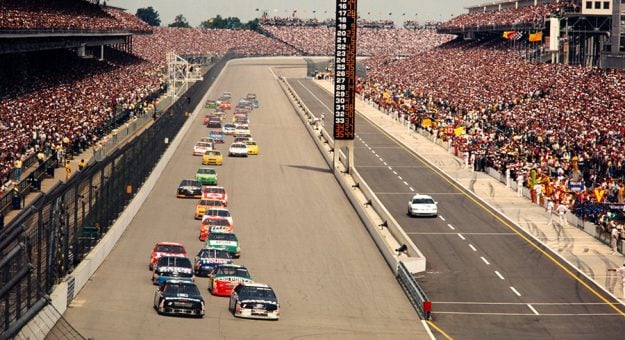For generations, Indianapolis Motor Speedway hosted only one race per season — the Indianapolis 500.
The process of changnig that started on June 22-23, 1992, when NASCAR brought stock cars to test at the vaunted 2.5-mile track for the first time since Len Sutton, Rodger Ward, Glenn “Fireball” Roberts, Marvin Panch and Paul Goldsmith ran their Pontiacs around the track during the early 1960s.
Goodyear conducted a “tire test” with invited drivers Rusty Wallace, Dale Earnhardt, Ernie Irvan, Ricky Rudd, Mark Martin, Bill Elliott, Darrell Waltrip, Davey Allison and Kyle Petty participating and nearly 50,000 fans in attendance. Elliott ran the best lap at 168.787 mph.
The inaugural Brickyard 400 was announced on April 14, 1993, and two more NASCAR tests were held at IMS before the Aug. 4-6, 1994, running of the event.
Pole qualifying for the much-anticipated race took place on Thursday, Aug. 4. A record 85 cars made qualifying attempts for 43 starting positions with H. B. Bailey the first to hit the track to a standing ovation from a raucous crowd.
Rick Mast, driving Richard Jackson’s No. 1 Ford, earned the pole for the 160-lap race when he topped the speed chart with a lap of 172.414 mph.
A crowd estimated at 350,000 began moving into the hallowed facility long before sunrise on Aug. 6, anticipating a history-making event.
Jeff Gordon, originally from California but a resident of nearby Pittsboro, Ind., for several years, was the fan favorite in an era before Hoosiers Tony Stewart or Ryan Newman made their way to NASCAR.
“When we got there and were running well — and qualified well — we thought a win could be possible and even more so because I had won a race in May at Charlotte,” Gordon said. “All of the sudden, we realized we figured out how to get to victory lane in one of the toughest races. So, of course, our confidence was high and the cars were strong. And that showed up right away. I didn’t know what to expect, but we were very competitive right from the beginning. Everything came together for us.”
Gordon led 93 of 160 laps, including the final five circuits after Ernie Irvan cut a right-front tire as the pair battled for the lead.
Geoff Bodine was an early contender, leading 24 laps. But his day ended when he and his younger brother, Brett, made contact while battling for the lead, sending the elder Bodine to the garage on lap 99.
Gordon and Irvan took advantage of the front downforce being generated in those closing laps, swapping the lead and fighting a loose condition each time they took the point. In the end, Gordon held steady and won the race by .53 seconds over Brett Bodine to secure the emotional victory. Bill Elliott, Rusty Wallace and Dale Earnhardt rounded out the top five.
Gordon earned $613,000 for what was his first of a record five Brickyard 500 victories.
“I just loved that track,” Gordon said. “I loved the fan support. I loved the first 10 years of going there because everyone was so excited. It was different and there was so much tradition there. Growing up through high school and all the years of fans supporting me there, it was as if I was the adopted local boy is how I always say it. To go there and perform at that level on that track is so special to me. That (the 1994 victory) is one of the days I’m most proud of.”
Gordon grew up wanting to race Indy cars but after success in USAC racing, NASCAR came calling and took his career in a completely different direction. He won four Cup Series championships and earned 93 premier series victories before his retirement in 2016.
“I think everyone was surprised and shocked that Tony George (president of IMS) and Bill France Jr. (president of NASCAR) would be able to make this deal happen,” Gordon said. “Everybody thought, ‘That’s Indy car territory and the Indianapolis 500 is sacred ground,’ and they can’t break tradition to bring stock cars there. That’s the only event that goes on at Indianapolis Motor Speedway.
“I think what we’ve seen happen over time is that it was exciting to go there in the early 1990s. People thought that level of hype would happen every year.”
Click below to continue reading.
